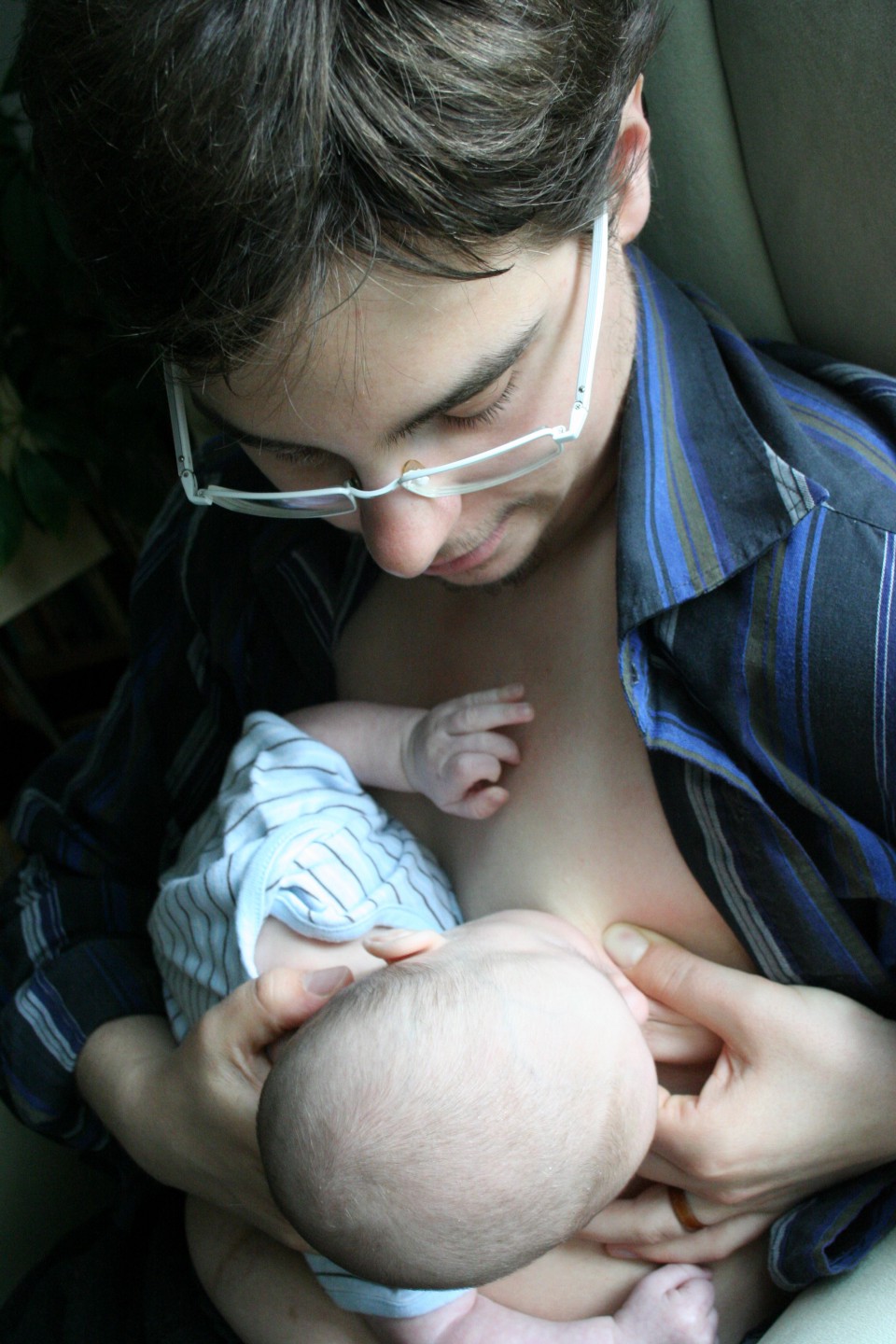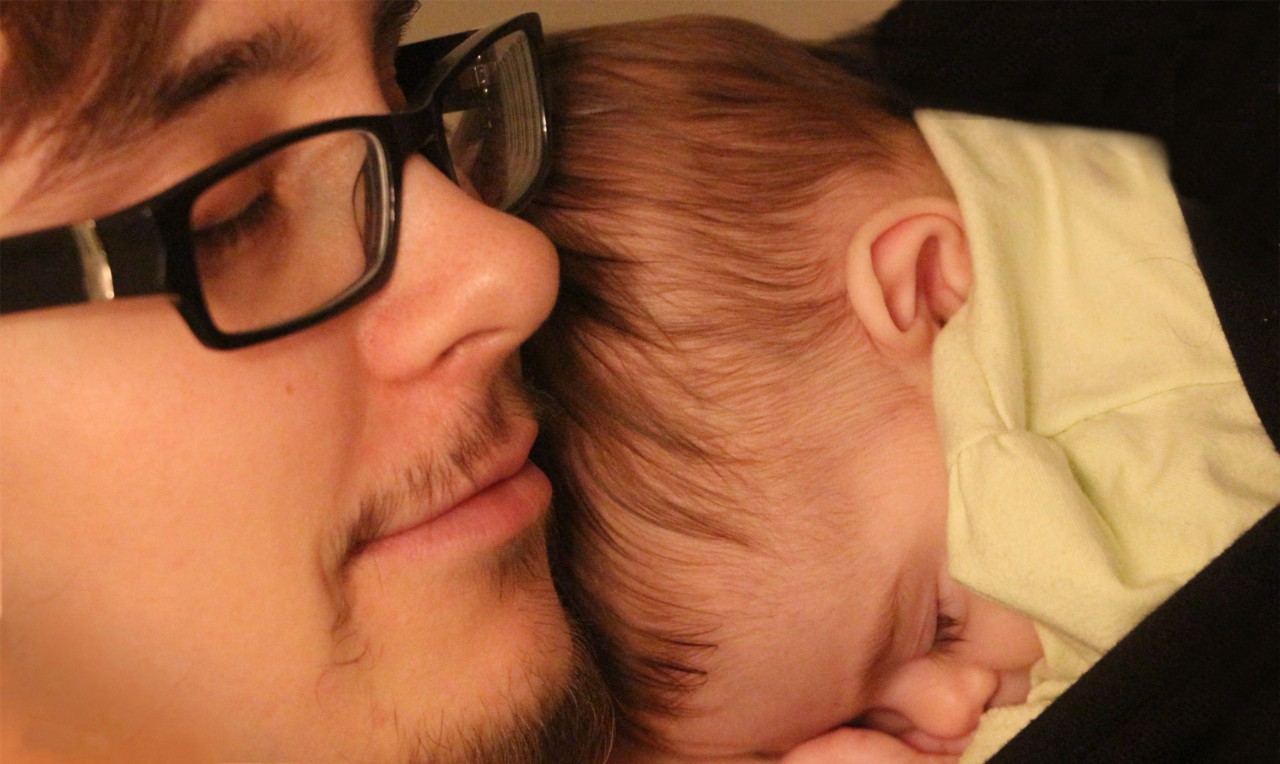Trevor MacDonald’s second pregnancy got complicated. That’s when a trans-friendly OBGYN became crucial.
By Marissa Higgins
Trevor MacDonald and his two children—now five years old and 18 months—enjoy a close bond with their local community. (Photo: Trevor MacDonald)
Even under the most conventional circumstances, pregnancy is an overwhelming emotional experience for anyone. For Trevor MacDonald, a 31-year-old transgender man based in Dugald, Manitoba, Canada, the whirl of emotions began as soon as he realized he was pregnant. “I was excited that we had a positive pregnancy test,” MacDonald says. “And also really anxious about telling some stranger on the phone that I was a pregnant, transgender guy.”
For MacDonald and other transgender and gender non-conforming people who go through fertility, pregnancy, and birth, the process of creating and carrying life can beget a unique paradox: What does it mean to be a pregnant man in a society that’s still skeptical of transgender people going to the bathroom? And what resources are available in our medical communities to make this process both safe and inclusive?
The biology behind MacDonald’s pregnancies was simple. MacDonald, who began his transition process from female to male at the age of 22, chose not to have a hysterectomy, therefore allowing him and his partner to conceive naturally. Earlier in his transition, MacDonald opted to take hormones in order to lower his voice, grow facial hair, and obtain a more masculine distribution of body fat. When he and his partner decided to conceive, he stopped taking testosterone and waited for his menstrual cycles to return, all under the supervision of his doctor. After several cycles, his period returned, and the couple was able to conceive.
“Strangers who didn’t know I was pregnant and transgender did not ever misgender me as female; I believe they saw [pregnant me] as a dude with a beer belly.”
Living in the world as a pregnant man in a society that closely links pregnancy with womanhood, however, is not always so seamless.
While MacDonald has the support of his partner, friends, and family, some people struggled with respecting his identity when he became pregnant. “People who had known me previously, and knew about the pregnancy, sometimes had a harder time using the correct pronouns,” he remembers. On the other hand, MacDonald largely escaped misgendering from people on the street and in public. As he recalls: “Strangers who didn’t know I was pregnant and transgender did not ever misgender me as female; I believe they saw [pregnant me] as a dude with a beer belly.”
In a society where transgender and gender non-conforming people routinely experience discrimination (and still lack many legal protections), MacDonald’s situation is one with no easy script. Living authentically and identifying as transgender complicates basic elements of existence, such as employment, physical safety, and housing. Not to mention the emotional exhaustion of having to explain and validate your gender identity to others. For people who do not identify as women, but nonetheless become pregnant and give birth, this dilemma often necessitates coming out again and again — even to strangers.

In spite of having top surgery, Trevor MacDonald is still able to chestfeed both of his children. (Photo: Trevor MacDonald)
MacDonald and his partner opted for home births with the support of a midwife in order to avoid repeatedly coming out to medical staff and personnel. With his first pregnancy, MacDonald did not choose a particular midwife. “I was so happy to be accepted by any midwifery clinic due to the local midwife shortage,” he explains, “that I simply went with the first one that called us back.”
For his second pregnancy, MacDonald was able to seek out a midwife whose recommendations said she was particularly nuanced with queer issues. “It was wonderful to work with someone from my own community who could more easily understand my needs,” he says.
As a trans man, MacDonald is not unique in his anxieties about coming out as transgender to medical staff and personnel. As Signey Olson, a certified nurse practitioner and midwife, explains: “For anyone with a uterus or ovaries who does not identify as a woman, seeking care for any ‘women’s health issue’ can be triggering and cause significant fear and anxiety.”
On a practical level, identifying as male or gender non-conforming in spaces traditionally geared toward women can necessitate frequent, time-consuming explanations, whether it’s to your attending doctor or to the security staff of your local hospital. According to a 2010 report from Lambda Legal, 70 percent of transgender respondents experienced discrimination while seeking medical care. A 2011 study from the National Center for Transgender Equality and the National Center for LGBTQ Task Force discovered that 28 percent of respondents postponed getting health care when they were ill or injured. Thirty-three percent of respondents delayed, or did not seek out, preventive care because of past negative experiences with doctors. What, then, are men like MacDonald to do when they need medical care for something as complex as a pregnancy?
During his second pregnancy, MacDonald experienced some alarming symptoms. “I had sudden, throbbing pain in the back of my leg and my midwife was concerned that it could be a blood clot,” he says. “Thankfully, the doctor at the hospital concluded that it was just a varicose vein.” Though his symptoms had a simple answer, going to the hospital as a transgender man was a challenge in itself.
“I had to come out [as transgender] to the security, the desk staff, the intake nurse, and a bunch of other nurses,” MacDonald says, though he notes that having a queer-inclusive midwife wound up making all the difference.
When his midwife learned about MacDonald’s concerning symptoms, she recommended he visit a local hospital, but, given his sensitive situation, did not leave him to fend for himself. “She called both hospitals in our area to find out which obstetrician was on call at each,” MacDonald says, “and then directed me to the one she thought would provide the best trans-inclusive care.”
For transgender patients, pointing to physicians who are safe and inclusive makes a world of difference. Inclusive medical personnel also have the unique opportunity to educate and prepare their peers and other providers, helping them better assist future patients. As Olson explains, “many transgender patients leave interactions feeling violated and invalidated due to invasive or unrelated questioning” about their gender identity and transition process. She remembers, in fact, seeing “patients visibly shaking and afraid of encountering yet another provider who will ‘other’ them.”
MacDonald’s anxieties about giving birth went beyond interactions with medical staff. Like many people who identify outside the traditional gender binary, MacDonald worried about how the experience of giving birth would affect his own mental state. “My main fear,” MacDonald says, “was that as a transgender person, I might experience a traumatic level of gender dysphoria during labor, and that this might affect my ability to have a safe birth.”

(Photo: Trevor MacDonald)
Many people experience gender dysphoria when they feel a disconnect between their body and their own identity and sense of self. “How would my body be able to open [to give birth] if I felt very dysphoric?” MacDonald recalls wondering. “‘Opening’ seemed to be the polar opposite of how I feel when I experience gender dysphoria.”
The experience of pregnancy and birth, and the journey of fertility to begin with, can be isolating experiences for people who do not identify with traditional notions of gender and sex. At the time of his first pregnancy, MacDonald did not personally know any other trans men who had given birth. When he lacked community, however, he decided to create some of his own: Back in 2012, MacDonald created Birthing and Breast or Chestfeeding Trans People and Allies, a Facebook group that now has over 1,900 members and welcomes both transgender individuals and allied health-care providers.
MacDonald regularly attends parenting groups in his local community too. “I think pretty much every parent no matter what their background understands that raising young kids can be exhausting and challenging,” he says. “We get together for visits and play dates, bring each other food when someone is having a difficult time, and pass along outgrown baby clothes.” Making parenting communities of all kinds open and accessible for the queer community, including transgender parents, is an easy way to shift toward a culture of acceptance and normality.
The world continues pushing for better and safer medical care for women through the cycle of fertility, pregnancy, and birth. As men like MacDonald remind us, though, we must work toward more inclusive safe spaces for all people who give birth, including men and those who do not identify with the traditional notions of masculinity and femininity.




